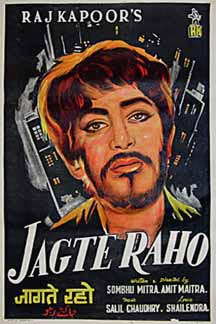Jagte Raho

Jagte Raho (translation: Stay Awake or Stay Alert) is a 1956 Bollywood/Bengali film, directed by Amit Maitra and Sombhu Mitra, written by Khwaja Ahmad Abbas, and produced by and starring Raj Kapoor.[2][3][4] The film centers on the trials of a poor villager (Kapoor) who comes to a city in search of a better life. However, the naive man soon becomes trapped in a web of middle-class greed and corruption.[5] The film also features a cameo by Nargis in the final scene.[1]
It was produced in Bengali as Ek Din Raatre, starring Raj Kapoor, Chhabi Biswas, Pahari Sanyal, Nargis Dutt and Daisy Irani.[6] The film won the Crystal Globe Grand Prix at the Karlovy Vary International Film Festival in Czechoslovakia in 1957.[7]
A poor peasant (Kapoor) from the village, who comes to the city in search of work, is looking for some water to quench his thirst. He enters an apartment complex, whose residents take him for a thief and chase him. He runs from one flat to the other trying to escape his predicament. Along the way, he witnesses many shady undertakings in the flats where he hides. Ironically, these crimes are being committed by the so-called “respectable” citizens of the city, who by day, lead a life totally in contrast to their nighttime deeds behind closed doors.
He is shocked by these events and tries to escape by evading the search parties that are patrolling the apartment building in search of the elusive thief. He is unfortunately seen, and people chase him to the roof of the building. He puts up a brave resistance and then descends by the water pipes onto the porch of a flat. He goes in to find a young girl (Daisy Irani). She talks to him and kindles a self-belief in the peasant, who determinedly tries to face the adversity waiting outside. But when he ventures out of the flat, he is surprised to find that nobody takes notice of him. He eventually leaves the apartment building, his thirst still unquenched. He hears a beautiful song and searching for its source arrives at the doorstep of a woman (Nargis) drawing water from a well.
His thirst is finally assuaged.The song “Zindagi Khwab Hai”, picturized on Motilal in Hindi was recorded as “Ei Duniaye Shobi Hoi” in the Bengali version and was picturized on Chhabi Biswas. Most of the story line is identical between the two versions, as were the songs; “Teki Main Jhuth Boliya”, sung by Mohammed Rafi and picturized on Sikh drivers is consistent in both versions. “Jago Mohan Pritam”, sung by Lata Mangeshkar is common to both versions – only the lyrics were changed to Hindi and Bengali, as applicable.

